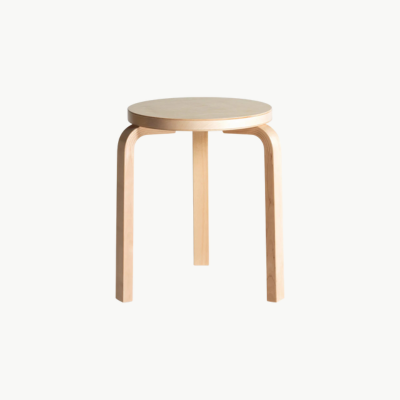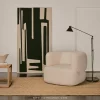Alvar Aalto
The Guy Who Made Modernism Feel Human
So here’s the thing about Alvar Aalto – he didn’t make flashy design. He wasn’t out here chasing trends or trying to make a statement. What he did instead? He made modernism soft. He made it feel. And in a world full of hard edges and steel, that was kind of revolutionary.
He was born in Finland in 1898, surrounded by forests, lakes, and long winters. And you can tell. His work is full of warmth and light and curves – the kind of stuff that feels like nature found its way into furniture and buildings.
Early Years
Nature Kid Goes to Architecture School
Aalto studied architecture at the Helsinki University of Technology, and opened his first studio in his twenties. At first, his work was clean and kind of textbook modernist. Lots of straight lines and functional layouts. But even then, there was something different. His buildings weren’t cold. They didn’t feel machine-made. You could tell he actually cared about how people would live and move inside them.
One of his first major projects was the Paimio Sanatorium in the 1930s – a hospital for tuberculosis patients. And honestly? It’s one of the best examples of how he thought. He didn’t just design the building. He thought about the experience.
Like, he angled the windows so patients could see the sky while lying down. He chose paint colors that felt calming. He even designed the Paimio Chair specifically for the space – something ergonomic and beautiful and easy to clean. That kind of attention? Rare.
Wood, Curves, and Furniture
That Feels Like a Hug
Let’s talk furniture, because this is where he really carved out his space (literally). While the rest of Europe was getting hyped on chrome and tubular steel, Aalto was bending birch plywood into shapes that didn’t even seem possible at the time. And somehow, they never looked forced.
His stuff was simple, but full of soul. There’s a softness to it. The Stool 60, the Armchair 41, the Tea Trolley, the Savoy Vase – these pieces are still around today because they’re that good. They’re not just functional – they’re beautiful without trying too hard.
And let’s be clear: he was doing the bent wood thing before the Eames duo made it a whole American moment. Respect where respect’s due.
Artek and the Bigger Picture
In 1935, he and his wife Aino Aalto (also a fantastic designer in her own right), started Artek with a couple of friends. The idea was to create furniture and objects that brought modern design into everyday life – nothing overly precious, just well-designed, durable pieces that people could actually use.
But Artek wasn’t just a shop. It was a whole vibe. A platform for art, architecture, and design thinking. It helped put Finnish design on the map in a big way.
Paimio chair
Not Just a Pretty Shape
Let’s start here – Armchair 41, also known as the Paimio Chair. It’s probably Aalto’s most famous piece. It’s made from bent plywood and has this elegant, floating seat that curves like a wave. But it’s not just sculptural – it was designed specifically to support breathing, since tuberculosis patients had to sit upright for better airflow. Functional and poetic.
It kind of sums him up perfectly.
Stool 60
The Quiet Power of a Circle
Next up is Stool 60, maybe his most iconic and accessible piece. You’ve seen it – even if you didn’t know it was Aalto. Three bent legs. One round seat. That’s it. Stackable, durable, quietly beautiful. First designed in 1933 and still in production today.
It’s so minimal, it almost feels invisible – but that’s the point. It just works. You can use it as a stool, side table, plant stand, whatever. It’s a design chameleon, and honestly? Every home could use one.
The Tea Trolley 900
Function That Feels Fancy
This one is a showstopper, but in a totally non-flashy way. The Tea Trolley 900, designed in 1937, has large, spoked wheels, a woven rattan shelf, and curved wooden handles. It was inspired by British tea culture and Japanese design, and somehow blends both perfectly.
It’s not just about rolling drinks around (though it does that). It’s about movement, form, and craft. The mix of materials is beautiful without feeling fussy. It’s probably one of the most charming pieces he ever made.
Armchair 42
The Sculptural Lounge
While the Paimio Chair gets a lot of attention, Armchair 42 is another one that fully captures Aalto’s style. Designed in 1932, it features a bent birch frame and a suspended seat that almost feels like it’s floating mid-air. The whole thing is formed from continuous curves – no hard angles, no unnecessary extras.
It’s sculptural, but not showy. Comfortable, but not bulky. It’s one of those pieces you could imagine in a gallery or in your reading nook. It’s got presence, but it doesn’t try too hard.
Aalto Screen
When a Divider Becomes a Sculpture
Let’s talk about one of his most underrated pieces: the Aalto Screen (also known as Screen 100). This thing is technically just a room divider – but it does so much more.
Made from thin, vertical strips of birch attached by canvas hinges, the screen moves like a ribbon. You can bend it, curl it, stretch it out. It’s functional (yes, it divides a space), but it’s also this gorgeous, flowing form that brings texture and movement into a room.
It’s a perfect example of how Aalto turned practical needs into elegant design statements. A screen didn’t need to be beautiful – but of course he made it beautiful anyway.
The Lounge Chair 43
Comfort in Curves
Another stunner – Lounge Chair 43. This one has no hard angles, no visible joints, no unnecessary parts. It’s just laminated birch, bent into these soft, rolling curves that hug your body. It’s shockingly comfortable for something that looks this light.
You can tell it was made by someone who understood how people actually sit – not how they’re “supposed” to sit. It’s simple, but kind of genius.
The Savoy Vase
Aalto in Glass Form
Even if you don’t know anything about design, you’ve probably seen the Savoy Vase. That organic, fluid shape? Iconic. Aalto designed it in 1936 for a luxury restaurant in Helsinki, and it became an instant classic.
What’s wild is how modern it still feels. There are no straight lines, no symmetry. It’s basically the anti-vase, and yet it’s been copied a million times. And none of the copies feel quite as right.
Not Just Buildings
Spaces That Breathe
Even as his furniture became iconic, Aalto never stopped designing buildings. And honestly? His architecture is underrated.
The Viipuri Library, the Baker House at MIT, Finlandia Hall, the Säynätsalo Town Hall – these spaces are quietly powerful. There’s always this sense of flow, of lightness. He hated the idea of buildings feeling rigid or overly formal. Instead, his structures move with you. They’re full of natural light, thoughtful materials, and subtle curves that guide you through.
He wasn’t afraid to mix materials either – brick, wood, glass, marble – all in the same space, and somehow it just worked.
Why He Still Matters
In a design world that often gets caught up in what’s “cutting edge,” Aalto’s work is like a reset. He reminds us that design doesn’t have to be loud. It doesn’t have to be cold. It just has to care.
And honestly? That’s something we need more of. His work isn’t screaming “look at me.” It’s quietly saying, “I’ve got you.”
The best part? His stuff still holds up. Not in a nostalgic way, but because it was never about a specific time. It was about people. And people haven’t changed that much.
So Why Does Alvar Aalto Still Matter?
Because his work is human. It doesn’t shout. It doesn’t need a filter or a tagline, it just feels good to be around.
He reminded the design world that people aren’t perfect, and design shouldn’t try to be either. It should respond. Adapt. Comfort. Surprise. He brought empathy into architecture. He made furniture that ages well—not just physically, but emotionally.
In a world that’s obsessed with more, faster, louder, Aalto is the calm in the room. The curve that softens a corner. The stool that just fits. He made modernism warmer, and that’s why he’ll always matter.


